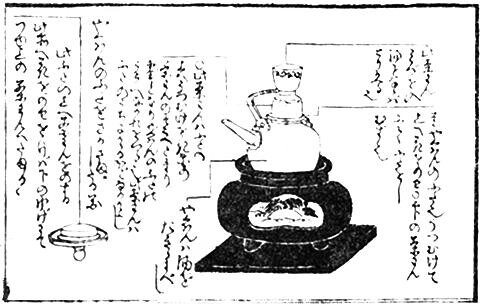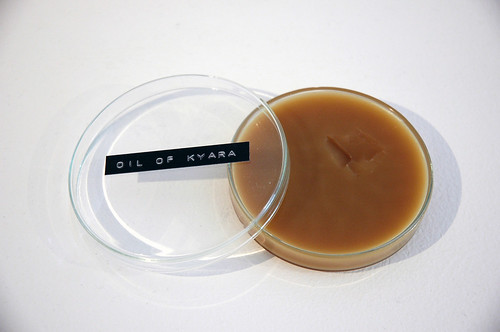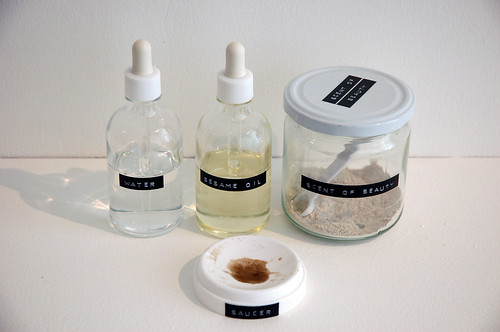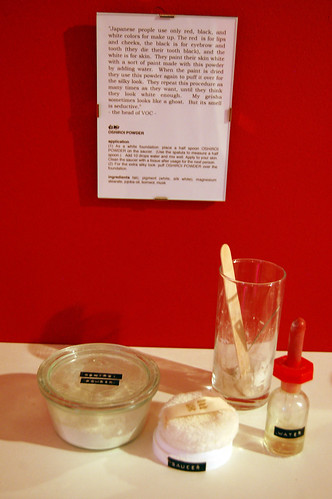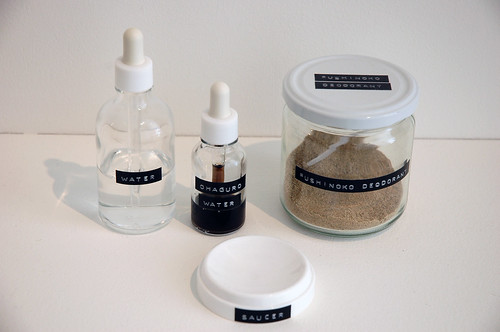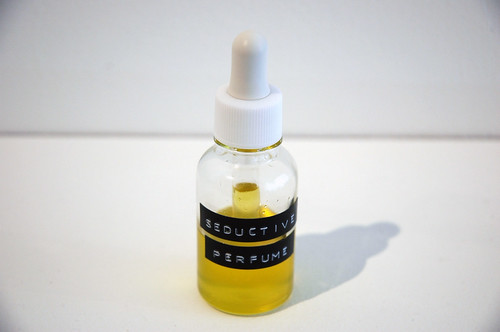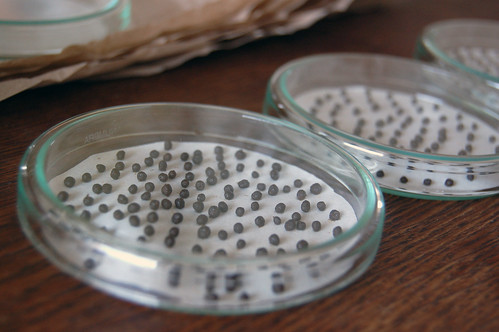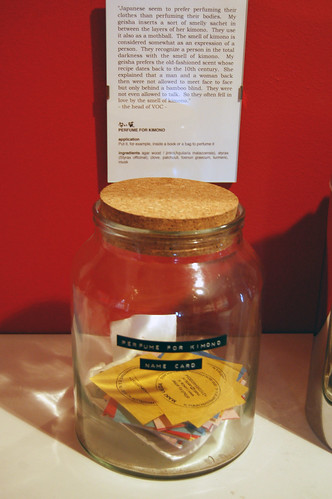Geisha's were using aphrodisiac scents as a tool for their business. Here are some cosmetics developed by Maki Ueda, to fill your imagination. They are developed manually by the artist based partly on the historical documents and partly on her imaginations.
[1] 花の露 DEW OF FLOWER
“Geisha's love the tonic water 'DEW OF FLOWER', a distilled water made from wild rose. The top class geisha's first started to wear it around 1640, and then later it became popular also among the middle and lower classes. Those who cannot afford it make it at home following the fashion book Miyako-Fuzoku-Kewaiden (1813) that illustrates how to distill with kettle and tea cup. “
- the head of VOC -
application:
(1) As a tonic water: spraying after washing your face will make your skin moisturised.
(2) For the finishing touch: spraying after puffing OSHIROI POWDER will make your face even more shiny.
ingredients:
wild rose water, clove, sandalwood, borneol
[2] 伽羅の油 OIL OF KYARA
"An buttery wax called 'OIL OF KYARA' is named after the best quality fragrant wood Kyara. The word Kyara is also used as a metaphor for anything best and gorgeous in the red light district. This wax is used both for skin and hair, so if someone wearing it comes nearby you'd notice it by smelling. There are specialized shops only selling this product in the big cities like Kyoto and Edo."
- the head of VOC -
application:
(1)As a crème
(2)As a hair wax
ingredients:
candle wax, bees wax, roasted sesame oil, pine resin, spikenard (nardostachys chinensis), clove, sandalwood, fennel seed, cinnamon, musk, borneol
[3] 美人香 SCENT OF BEAUTY
"The whiter the skin is, the more beautiful the geisha's are - that's how they think. So geisha's put their effort to bleach their skin in whatever way. The powder called 'BIJINKO' consists of medicinal Chinese herbs that is considered effective for whitening. So geisha's try to use this powder in many different ways; as a cleanser, as a lotion, as a facial mask, etc etc..."
- the head of VOC -
application:
(1) As a cleanser: use this powder when washing your face.
(2) As a lotion: place a half spoon powder on the saucer. (Use the spatula to measure a half spoon.) Add 10 drops water and 7 drops sesame oil, and mix well. It gets emulsified and forms a sort of lotion. Apply it on your skin, especially in the wrinkles to equalize the skin surface. Clean the saucer with a tissue after usage for the next person.
(3) As a facial mask: mix the powder with water on your palm and apply it to your skin. Leave it on for half a day and wash it off.
ingredients:
mung bean, arrowroot powder, talc, bai zhi (angelica dahurica), fu zi (radix aconiti lateralis praeparata), sandalwood, spikenard (nardostachys chinensis), borneol
[4] 白粉 OSHIROI POWDER
"Japanese people use only red, black, and white colors for make up. The red is for lips and cheeks, the black is for eyebrow and tooth (they die their tooth black), and the white is for skin. They paint their skin white with a sort of paint made with this powder by adding water. When the paint is dried they use this powder again to puff it over for the silky look. They repeat this procedure as many times as they want, until they think they look white enough. My geisha sometimes looks like a ghost. But its smell is seductive."
- the head of VOC -
application:
(1) As a white foundation: place a half spoon OSHIROI POWDER on the saucer. (Use the spatula to measure a half spoon.) Add 10 drops water and mix well. Apply to your skin. Clean the saucer with a tissue after usage for the next person.
(2) For the extra silky look: puff OSHIROI POWDER over the foundation.
ingredients:
talc, pigment (white, silk white), magnesium stearate, jojoba oil, borneol, musk
[5] 五倍子粉で腋臭を退治する法 FUSHINOKO DEODORANT
"Japanese women don't have much distinctive body odor compared to ours, but they are quite nervous about it. Their sanitary sense is sometimes fanatic. In order to erase the underarm odor, my geisha uses a powder called 'FUSINOKO'. She tacitly suggests me to wear it too."
- the head of VOC -
application:
As a deodorant: place a 1 spoon fushinoko on the saucer. Add water and mix well. Apply to your underarm. Clean the saucer with a tissue after usage for the next person.
ingredients:
fushinoko (the powder is ground from a bump of sumac tree. It contains tannin. The bump is created when greenflies parasite, so the powder actually contains a lot of insect corpses.)
[6] 丁字油 SEDUCTIVE PERFUME
"Ordered by the Japanese government that foresaw the medicinal value of essential oils, Japanese Hollandologists (scientists) learned from us the methods of distillation and oil maceration in the middle of 17th century. The clove oil became later a consumer product. It was sold not only as a medicine against the tooth pain, but also as a aphrodisiac medicine. Clove is one of our important trading products. We trade Indonesian clove with Japanese Camphor."
- the head of VOC -
application:
(1) As a perfume: spray it on your skin
(2) As a medicine: use it for a tooth pain or for a scar
ingredients:
clove, sesame oil
[7] 体身香 PERFUME TO INGEST
"The Chinese legendary Yang Guifei was one of the Four Beauties of ancient China. She was the beloved consort of Emperor Xuanzong of Tang for many years because of her body odor. She is presumed to have been using a medicine of balls that look like some kind of poop. My geisha is also using this medicine, but I do not comment anything on its result."
- the head of VOC -
application:
Ingest maximum1 ball a day. (at your own risk).
ingredients:
clove, patchouli, foenun graecum, spikenard (nardostachys chinensis), bai zhi (angelica dahurica), tang kuei-ch (angelica sinensis), bing lang (semen arecae), musk, ume-pase, honey
[8] 匂い袋 PERFUME FOR KIMONO
"Japanese seem to prefer perfuming their clothes than perfuming their bodies. My geisha inserts a sort of smelly sachet in between the layers of her kimono. They use it also as a mothball. The smell of kimono is considered somewhat as an expression of a person. They recognize a person in the total darkness with the smell of kimono. My geisha prefers the old-fashioned scent whose recipe dates back to the 10th century. She explained that a man and a woman back then were not allowed to meet face to face but only behind a bamboo blind. They were not even allowed to talk. So they often fell in love by the smell of kimono."
- the head of VOC -
application:
Put it, for example, inside a book or a bag to perfume it
ingredients:
agar wood / jinko(Aquilaria malaccensis), styrax (Styrax officinal), clove, patchouli, foenun graecum, turmeric, musk

 English (UK)
English (UK)  日本語
日本語 

